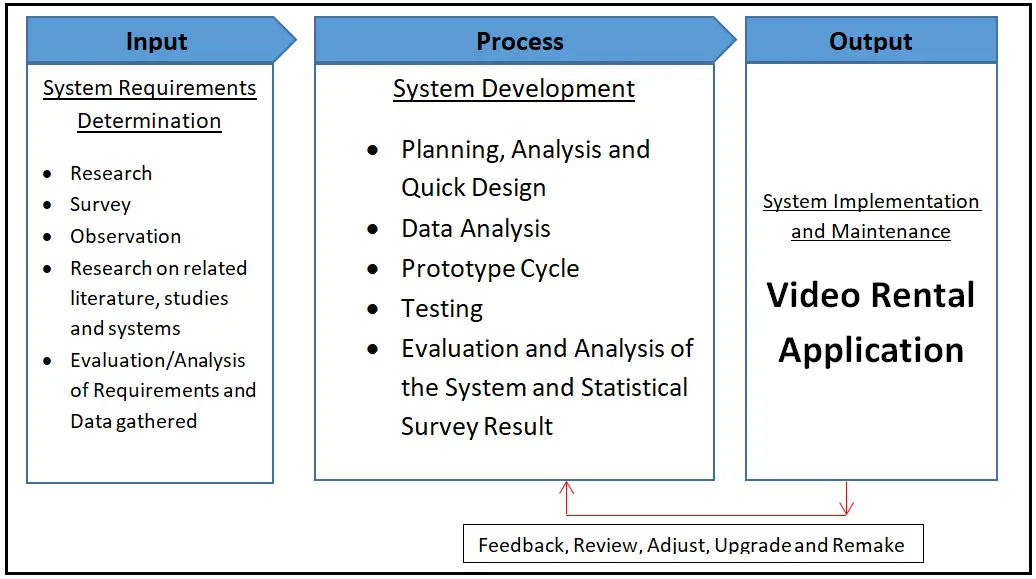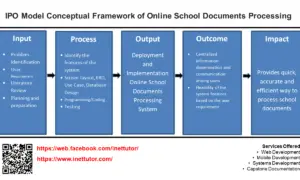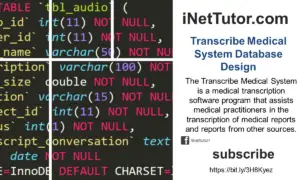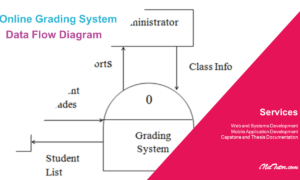Video Rental Application Conceptual Framework
This article will present the process of developing a conceptual framework for your capstone project, Video Rental Application. The conceptual framework will be developed based on the input, process, output (IPO) model.
About the Project
Table of Contents
Most of population around the globe spent their time on watching videos and movies as for their entertainment. Most of them rent videos at the cable TV which is hard because they cannot get an update if ever they are far away from home. Thus, the researchers of the system entitled online video rental application with android support made a better way in order to fill the gap between people who love watching videos. They are proposing a system which is mobile device application online video rental for them to watch wherever they are. This system would not make them worry about losing access in cable TV because they can now stream online, they only need to have a data server I order to rent and watch. And what exciting the most is, it is an android support, so, it doesn’t matter if buyers/users are using android phone, they can now freely access. The researchers made users feel valued because of reaching the satisfaction of the users.
Objectives of the Study
The objective of this study on Video Rental Applications is to evaluate the current video rental market and to determine the potential benefits and challenges of implementing a video rental application. The study aims to identify the needs and preferences of video renters and to determine the key features and functionalities that would make a video rental application successful. The study will also consider the impact of the rise of streaming services on the video rental market and the potential for a video rental application to compete in a changing market. The findings of this study will provide valuable insights and guidance for video rental companies and entrepreneurs looking to develop and launch a video rental application.
- To produce the system that will meet the need of the users.
- To make a system that would help gain more profit on the side of the owner.
- To create an online video rental system that is better than the current system.
- To develop system that would easily catch the attention of the buyers/renters.
- To design a system that is more convenient and has a comfortable environment for the users.
Conceptual Framework Diagram

The image shown above is the Conceptual Framework Diagram of the capstone project, Video Rental Application. It is based on the IPO model, also known as the input, process, and output model.
What is Conceptual Framework?
A conceptual framework is a visual representation of the underlying relationships, concepts, and ideas that guide the development of a system or application. The purpose of a conceptual framework in the development of a Video Rental Application is to provide a clear and structured understanding of the problem, goals, and requirements of the application. The conceptual framework serves as a roadmap for the development process, helping to ensure that the final product meets the needs and expectations of video renters.
The conceptual framework of a Video Rental Application typically includes a detailed analysis of the current video rental market, the needs and preferences of video renters, and the competitive landscape. It also includes a definition of the key features and functionalities of the application, such as the ability to browse and search for videos, place holds and rentals, and manage rental history. The conceptual framework also considers the impact of the rise of streaming services on the video rental market and the potential for a video rental application to compete in a changing market.
In conclusion, the conceptual framework for a Video Rental Application is a critical tool for the development process, providing a clear and structured understanding of the problem, goals, and requirements of the application. By using a conceptual framework, developers can ensure that the final product meets the needs and expectations of video renters and provides a competitive and user-friendly experience.

Input
The project will begin by evaluating the present process, which will lead to the stage of doing research, survey and observation. The researchers will also need to compile relevant papers and systems to use as a guide for the project’s development. After all such process, the researchers will evaluate and analyze the requirements and data gathered.
Process
The researchers will select and choose the optimum software development life cycle model for the project in this section.
Planning, Analysis and Quick Design
During Analysis and Quick Design, the researchers did a personal interview with the respondents and the chosen client where the study was conducted. The respondents were given the chance to suggest how the system will be designed. After conducting the data gathering, the researchers made an initial design for the proposed system.
Data analysis
Consultation is used to gather requirements from end users and generate ideas. We also distributed a survey questionnaire that was authorized by three experts (IT Expert, English Grammarian, and Researcher). And these questionnaires functioned as our data gathering tool, measuring the performance of the manual system that served as the foundation for the development of our proposed system.
Prototype
The prototype and planned system features are developed at this phase. A concrete understanding of how the system will function is also created. We identify all of the necessary system inputs and outputs, as well as the design of data, processes, and interfaces, in this part.
Testing
In this phase, the researcher performed series of testing to check for any possible problems may arise during implementation and operation of the software and if the specification has been met.
Evaluation and Analysis of the System and Statistical Survey Result
This will include the feed backing of the proposed system after it will be implemented and had undergone testing by three Experts. It will also inform the researchers and the developer if there are any bugs, suggestion and if the system’s functionality will work well.
This will discuss the implementation of the proposed system wherein Three (3) Experts will evaluate the proposed system. This will also discuss if the recommended functions and suggestion are met.
Output
The project comes to life and is executed in the real world after all of the necessary procedures have been completed. A new project is born, and it will be maintained for the project’s long-term survival.
The Video Rental Application has the potential to deliver several significant outcomes and outputs. Firstly, by providing a convenient and user-friendly experience for video renters, the application can increase customer satisfaction. Renters can easily search for, hold, and rent videos, as well as manage their rental history, all from the convenience of their own device. Additionally, the automation of manual processes involved in video rental, such as tracking inventory and rental history, can improve operational efficiency for video rental companies and businesses. Furthermore, the Video Rental Application provides a tool for these companies and businesses to compete in a changing market where the rise of streaming services has impacted the traditional video rental industry. The application has the potential to increase revenue through increased rental transactions and customer loyalty, and it also provides valuable data and insights about customer behavior and preferences, which can be used to inform decisions about operations and strategies.
Summary
This research article focuses on the conceptual framework diagram of the Video Rental Application. The input, process, and output (IPO) model serves as the conceptual framework for the investigation. The input phase includes Research, Survey, Observation, Research on related literature, studies and systems and Evaluation/Analysis of Requirements and Data gathered. When the input phase is finished, the researchers will move on to the process stage. The Software Development Life Cycle (SDLC) approach is employed (SDLC). The SDLC technique includes Planning, Analysis and Quick Design, Data Analysis, Prototype Cycle, Testing and Evaluation and Analysis of the System and Statistical Survey Result. The final stage before the developed system is implemented and used is the output phase. The researchers will be in charge of the newly formed venture.
Readers are also interested in:
Car Rental System Use Case Diagram
Car Rental Software Free Source code
Bike Rental System Free Template in PHP and Bootstrap
You may visit our Facebook page for more information, inquiries, and comments. Please subscribe also to our YouTube Channel to receive free capstone projects resources and computer programming tutorials.
Hire our team to do the project.


